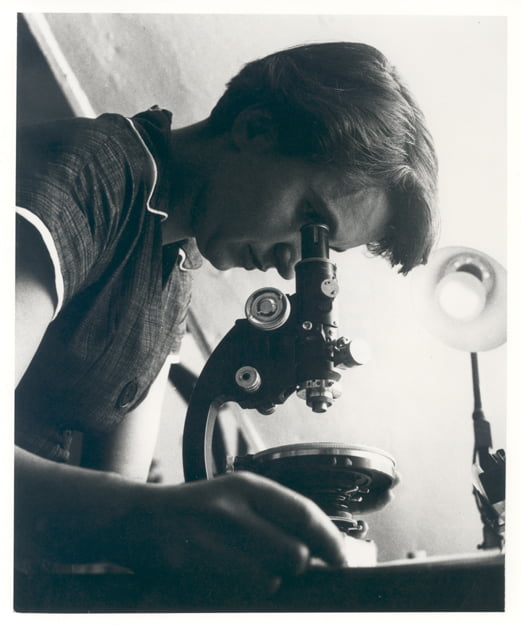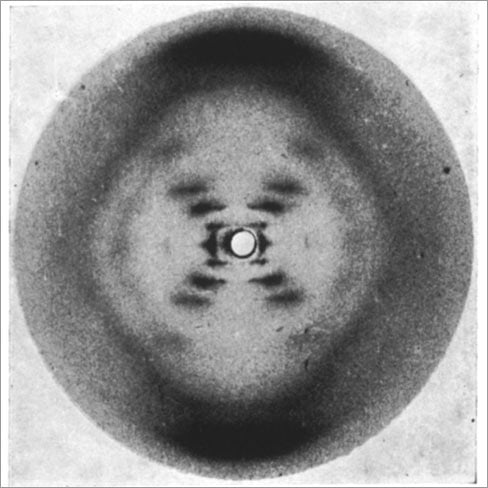It’s commonly believed that James Watson and Francis Crick discovered the double helix shape of DNA. But in fact, they based their work on one of their colleagues at King’s College in London – Rosalind Franklin, an x-ray diffraction expert whose images of DNA proteins in the early 1950s revealed a helix shape. It wasn’t until they saw Franklin’s work that Watson and Crick began hunting for the long, braided twist that turned out to be DNA’s true shape.
Why wasn’t Franklin honored for her contributions? Many have argued that her early death prevented her from getting the recognition she deserved, since Nobel Prizes can only go to living people. Others have suggested something slightly more sinister.
Franklin’s groundbreaking work was so good that she was able to secure a highly coveted position in the biology department at a top university – even though she lived at a time when it was widely believed that women could not become scientists. And yet she could not have casual meetings with colleagues in her own college’s Common Room, which was reserved for men only. To be fair, many of her scientifically-minded colleagues also avoided the Common Room, which was said to be packed with stuffy old reverends.
And yet the same prejudices that prevented her from entering the Common Room appear to have bled over into her colleagues’ views of her. Watson, who was in 2007 suspended from his research position for making sexist and racist comments, dismissed Franklin’s contributions to the discovery of DNA’s structure in his memoir The Double Helix. Many years later, both Watson and Crick admitted that they had been too dismissive of Franklin’s work, and that her discoveries were what led to their own.
There is now ample evidence from multiple sources that Franklin’s colleagues and graduate students at King’s College showed her x-ray images of DNA to Watson and Crick without her permission or knowledge. The so-called Photo 51 (pictured here) provided proof that DNA’s structure was probably a helix. Several witnesses – including Crick and Watson themselves – say that the two researchers saw this photo before “discovering” the double helix.
It’s hard for us to imagine now how such a thing could have happened. It’s almost as if there were a conspiracy to credit two “nice” men, instead of a Jewish woman, with the DNA discovery that revolutionized the twentieth century. In reality, it was probably rank prejudice combined with the same cutthroat scientific competitiveness that has dogged many great discoveries. For example, many historians argue that Alexander Graham Bell “stole” his telephone patent out from under another researcher – a robbery that’s arguably as great as the one that ripped the glory of the double helix discovery from Franklin’s hands.
Luckily Franklin’s contributions to science haven’t been erased from history. She may have suffered from an unfair lack of recognition in her lifetime, but her legacy lives on in both molecular biology and microscopy. The Royal Society offers an annual Rosalind Franklin Award, and there’s even a university named after her.
Still, it seems a crime that she’s not rightly credited as the person who discovered DNA’s structure. Currently, the two strands that form DNA’s helix are nicknamed Watson and Crick. Perhaps it’s time for a new naming scheme. How about Franklin and Crick? Or Franklin and Wilkins (her student, who was also a Nobel winner)? That seems like a proper way to memorialize the scientist who actually discovered the molecule’s structure in the first place.
Source: https://io9.gizmodo.com/the-unsung-hero-who-discovered-the-double-helix-5761388
See Also: https://www.thoughtco.com/rosalind-franklin-biography-3530347
Recommended Reading:
 Rosalind Franklin: The Dark Lady of DNA – In 1962, Maurice Wilkins, Francis Crick, and James Watson received the Nobel Prize, but it was Rosalind Franklin’s data and photographs of DNA that led to their discovery.
Rosalind Franklin: The Dark Lady of DNA – In 1962, Maurice Wilkins, Francis Crick, and James Watson received the Nobel Prize, but it was Rosalind Franklin’s data and photographs of DNA that led to their discovery.
Brenda Maddox tells a powerful story of a remarkably single-minded, forthright, and tempestuous young woman who, at the age of fifteen, decided she was going to be a scientist, but who was airbrushed out of the greatest scientific discovery of the twentieth century.




